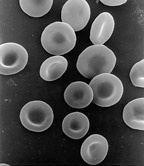 | ||
Red blood cell distribution width (RDW or RDW-CV or RCDW and RDW-SD) is a measure of the range of variation of red blood cell (RBC) volume that is reported as part of a standard complete blood count. Usually red blood cells are a standard size of about 6-8 μm in diameter. Certain disorders, however, cause a significant variation in cell size. Higher RDW values indicate greater variation in size. Normal reference range of RDW-CV in human red blood cells is 11.5-14.5%. If anemia is observed, RDW test results are often used together with mean corpuscular volume (MCV) results to determine the possible causes of the anemia. It is mainly used to differentiate an anemia of mixed causes from an anemia of a single cause.
Contents
Deficiencies of Vitamin B12 or folate produce a macrocytic anemia (large cell anemia) in which the RDW is elevated in roughly two-thirds of all cases. However, a varied size distribution of red blood cells is a hallmark of iron deficiency anemia, and as such shows an increased RDW in virtually all cases. In the case of both iron and B12 deficiencies, there will normally be a mix of both large cells and small cells, causing the RDW to be elevated. An elevated RDW (red blood cells of unequal sizes) is known as anisocytosis.
An elevation in the RDW is not characteristic of all anemias. Anemia of chronic disease, hereditary spherocytosis, acute blood loss, aplastic anemia (anemia resulting from an inability of the bone marrow to produce red blood cells), and certain hereditary hemoglobinopathies (including some cases of thalassemia minor) may all present with a normal RDW.
Calculations
The "width" in RDW-CV is sometimes thought to be "misleading," since it in fact is a measure of deviation of the volume of RBCs, and not directly the diameter. However, "width" refers to the width of the volume curve (distribution width, here presented as the Coefficient of Variation, or CV), not the width of the cells. Thus, it is a reasonably accurate term.
Mathematically, the RDW-CV is calculated with the following formula:
RDW-CV = (Standard deviation of MCV ÷ mean MCV) × 100.Normal RDW
When anemia is seen in the presence of a normal RDW, one must have a high suspicion towards Thalassemia as the cause of anemia and a Mentzer Index should be done from the CBC report itself to confirm.
High RDW
Iron Deficiency Anemia: usually presents with high RDW with low MCV
Folate and vitamin B12 deficiency anemia: usually presents with high RDW and high MCV
Mixed Deficiency (Iron + B12 or folate) anemia: usually presents with high RDW with MCV being high, low or often normal range
Recent Hemorrhage: typical presentation is high RDW with normal MCV
A false high RDW reading can occur if EDTA anticoagulated blood is used instead of citrated blood. See Pseudothrombocytopenia.
This can be diagnosed through CBC (Complete Blood Count).
